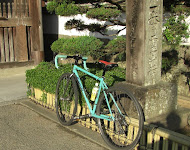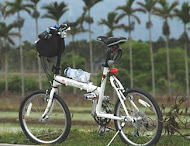 view the big map with a meters above the sea level graph
view the big map with a meters above the sea level graph
 view the big map with a meters above the sea level graph
view the big map with a meters above the sea level graph
| The Australian cyclist Gus, who gave me the information about the Misaka Pass last week, is staying in Odawara. We decided to meet in Enoshima, which is the halfway point between my home and Odawara. He owned cottages on the Gold Coast.  He said that he is a test pilot of wooden bicycles now !? He said that he is a test pilot of wooden bicycles now !?He stays in Japan every year for two or three months. He came to Enoshima for the first time and so I guided him around the island. G: Is that a temple? T: No, that is a shrink. G: Taka san, I don't think that is a shrink. T: Huh, that is a shrine. Don't mind. |
He spoke about the wooden bike with passion. We can make a comfortable bike with enough hardness if we put hard wood and soft wood together. Carbon cannot have the "bend" that wood has.  There are wooden bike makers such as RENOVO HARDWOOD BICYCLES in U.S.A. |
| Because he explained it based on the property of the materials, he was persuasive. |
76.92Km
 view the big map with a meters above the sea level graph
view the big map with a meters above the sea level graph
| My targets of today are two old mountain passes. One is Sasago Pass. There, you will find the Koshu-kaido, built in the Edo era/17th century, through which a railroad and a highway pass now. Another is Misaka Pass. Located there is a road from the Kamakura era/12th century. According to legend, Yamato Takeru went through on an eastern expedition in the second century. Both roads I cycled today are old. The traffic decreased after a new tunnel was built. It is a good way to go by bicycle. The old Sasago tunnel is dignified despite the fact that the width is only 3.0m.  |
| Subsequently, when I tried to go up to Misaka Pass, there was a notice board which said that the route is closed. I was worried whether a bicycle could go or not. Fortunately for me, one cyclist came down. He is an Australian touring Japan. He said that if you carried your bicycle on your shoulder for 40m, you can pass through the mountain pass. His blogs are these. ride japan boat building practice |
 |
 It was 40 meters precisely to have carried on.  |
The road closed to traffic was pleasantly peaceful.  |
96.8Km/Total 8h |
 view the big map with a meters above the sea level graph
view the big map with a meters above the sea level graph
 view the big map with a meters above the sea level graph
view the big map with a meters above the sea level graph
 view the big map with a meters above the sea level graph
view the big map with a meters above the sea level graph
 view the big map with a meters above the sea level graph
view the big map with a meters above the sea level graph
 The unsettled autumn skies.
The unsettled autumn skies.
On such a day, I had better advance remodeling of Katakura silk, but it is complex and troublesome. Katakura silk CRITERIUM (made in 1986)
Katakura silk CRITERIUM (made in 1986)
This bicycle ran the Tour De Yatsugatake in 1988.
Frame:chromium molybdenum steel.
Shimano 600-EX full set.
Rear derailleur:SIS 6 speeds.
Rim: MAVIC, Steering Wheel:Nitto, Saddle:Kashima.
 view the big map with a meters above the sea level graph
view the big map with a meters above the sea level graph
 95.24km /Total 8h
95.24km /Total 8h




















